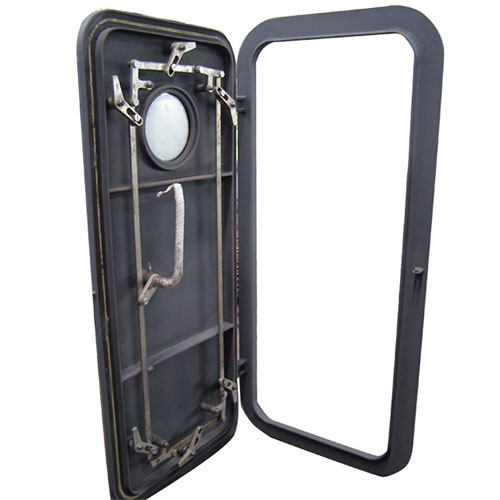Fire and Watertight Rated Marine Doors
Marine operations are exposed to the harshest environments, battling hazards like flooding, fire, and severe weather events. To reduce the risk of these hazards, marine doors should be designed to resist fire and water ingress, while maintaining the structural integrity. Fire and watertight rated marine doors play an important part in ensuring the security of passengers, crew members and the vessel.
Table of Contents
Importance of Fire and Watertight Ratings in Marine Doors
Fire Ratings
Marine fire-proof doors are made to withstand flames and high temperatures for a specified time that can range between 30 and 120 minutes. This protection stops the rapid spreading of smoke and fire and allows safe evacuation routes, and protecting crucial areas like living areas and engine rooms. The fire ratings ensure that the structural strength is preserved in time for emergency rescue and firefighting operations.
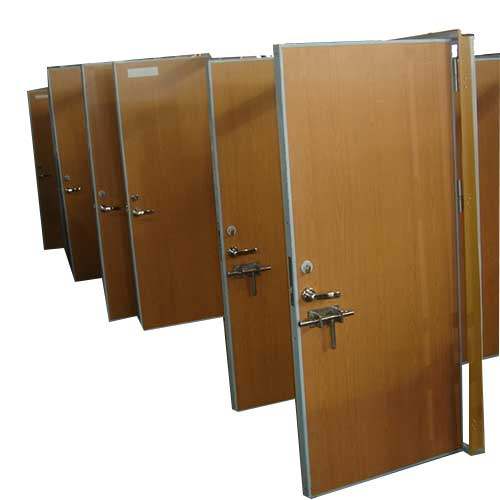
Watertight Ratings
Watertight doors prevent water from entering between ship compartments when flooding occurs due to damage to the hull or other causes. They are designed to withstand the high pressure of hydrostatic in order to maintain the integrity of the compartment, as well as keeping the vessel’s stability and buoyancy. The watertight rating is essential to stopping catastrophic flooding and capsizing.
Dual-rated Marine Doors
Doors that are able to hold both water- and fire-proof ratings offer a comprehensive level of protection. They contribute to the ship’s compartmentalization, which is fundamental in isolating hazards and maintaining safe operational zones. This double protection increases the ship’s ability to survive in emergency situations by securing passengers, crew and cargo.
Compliance and Regulation
International maritime regulations, such as SOLAS and the guidelines issued by classification societies like DNV, ABS, and Lloyd’s Register, mandate strict watertight and fire-proof standards for doors used in marine vessels. Compliance assures the vessel is in compliance with the legal specifications, safety standards and insurance requirements.
What are Fire-rated Marine Doors
Definition and Purpose
The fire-rated marine doors are specially engineered doors that are used on platforms for offshore vessels, ships and marine facilities to limit the spreading of smoke, fire and heat across different areas. They are designed to contain fires within a particular space, limiting its effects and allowing for firefighting and evacuation efforts.
Construction and Materials
The doors are made of material that is resistant to fire, such as aluminum or steel and are often stuffed with non-combustible insulation such as mineral wool. The design makes sure that the doors are able to withstand extreme temperatures for a specific time frame without compromising the structural quality. They can also be fitted with features like intumescent seals which expand when subjected to temperatures, thus preventing fire and smoke from escaping through gaps.
Classification and Ratings
The classification of fire-resistant marine doors is according to the time they can withstand the danger of fire. According to the International Convention for the Safety of Life at Sea (SOLAS) they are divided into the A, B or C classifications:
- Class A doors offer the highest degree of protection with fire resistance usually for sixty minutes, or even more.
- Class B doors provide moderate fire protection, normally lasting 30 minutes.
- Class C doors have a low resistance to fire and are primarily employed in areas with a lesser risk of fire.
They are based on rigorous testing and verification by reputable classification societies, like DNV, ABS, or Lloyd’s Register.
Applications on Board
Doors for marine fire-rated doors are typically used in areas that are critical to vessels, like engines rooms, stairwells control rooms, accommodations spaces and galleys. These are areas in which the danger of fire is greater, or where a tighter seal is required to ensure the safety of people and crucial equipment.
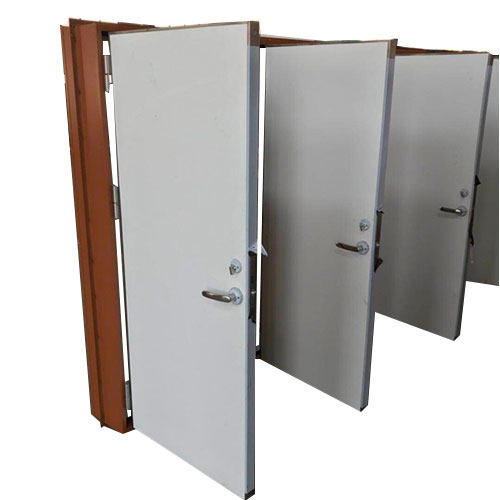
What are Watertight Marine Doors
Definition and Purpose
Marine watertight doors are specifically made doors that are installed on vessels and offshore structures to stop the flow of water from one area to the next. They are an essential element of a vessel’s damage control and safety measures especially in the event of hull cracks or flooding, as well as other emergency situations. They are designed to maintain stability and buoyancy by securing water within an area specific to the vessel.
Design and Construction Features
Watertight marine doors are usually constructed of sturdy materials like aluminum or steel. They have compressors, gaskets or seals that permit them to form a strong solid seal against pressure from water. The design of sealing ensures that there are no leaks of water after the door has been shut and sealed.
Watertight doors for marine use are available in a variety of designs, like hinged, sliding, or rapid-acting, dependent on the location and requirements for operation. Certain models can be operated manually and others are controlled remotely or electronically particularly in areas beneath the surface.
Function in Flood Prevention and Damage Control
They are used to separate the ship into watertight parts. When there’s crash or a damage to hull the affected area can be closed off by the use of a watertight doors, which prevents the spread of water across the vessel. This can significantly increase the odds of survival for the vessel and its crew which allows for time to repair evacuation, repair, or help.
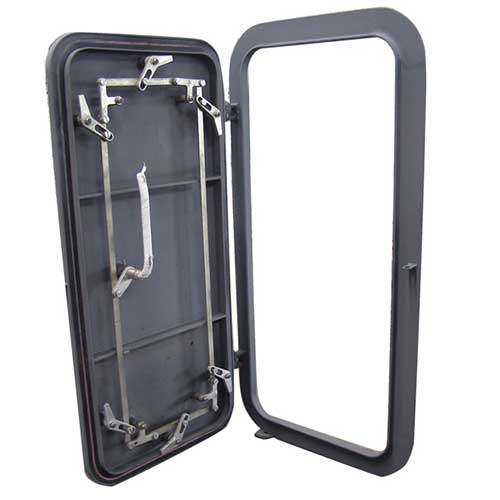
What are Fire and Watertight Rated Marine Doors
Marine watertight and fireproof doors are essential safety features employed in offshore and ship structures. They are designed to serve two purposes to stop the spread of smoke and fire as well as preventing water from entering between the compartments. Combining watertightness and fire resistance they provide complete protection for areas that are susceptible to dangers at sea.
Dual-Purpose Protection
In contrast to standard doors, which serve just one function that are fire-proof and watertight, rated marine doors are designed to resist high-temperature conditions as well as hydrostatic pressure. This makes them indispensable for areas with high risk, like engine rooms, control centers and lower deck corridors and bulkhead passageways.
Their capability to stop the spread of fire while blocking floodwater is crucial for maintaining the structural integrity of the vessel and securing the lives of people in times of need.
Construction and Materials
The doors are constructed using a reinforced steel structure and insulated material that is able to withstand the flame for a specific time typically being rated as B-30, A-60 or similar classifications under IMO (International International Maritime Organisation) rules. They also have high-strength seals and compression mechanism to ensure that they are watertight after closing.
Additional features include:
- Intumescent seals that are heat activated to protect against fire.
- Locking systems that are either manual or hydraulic to resist pressure.
- Remote control capabilities for central security and safety functions.
Applications in Maritime Safety
These doors are strategically placed in areas where both flood and flooding dangers exist for example:
- Bulkheads are divisions of major compartments.
- Engine rooms and the adjacent control rooms.
- Emergency generator rooms.
- Cargo and pump rooms on tankers.
Their presence ensures that crucial systems are protected and isolated in the event of flooding or fire and flooding, thereby ensuring the ship’s stability, and also increasing the safety margins of crew members.
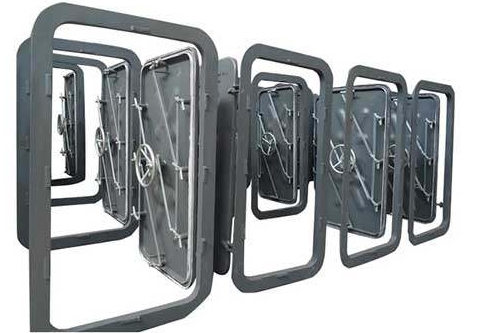
Classifications and Standards in Marine Doors
| Classification / Standard | Description | Typical Application |
| SOLAS (Safety of Life at Sea) | International convention that establishes minimum safety standards for vessels and requiring door requirement | Watertight and fireproof doors on commercial vessels on all types |
| IMO Fire Safety Code | Provides fire resistance ratings and test procedures for doors used in marine applications. | Doors that are fire-rated (A B, C, A classes) |
| DNV (Det Norske Veritas) | Classification society which provides guidelines and certifications for marine equipment | Design approval Installation, testing, and approval |
| ABS (American Bureau of Shipping) | Classification society that sets standards for safety of ships and certification | Watertight and fire-proof door standards and their approvals |
| Lloyd’s Register (LR) | Classification society that includes maritime safety standards and inspection protocols | Monitoring compliance and certification |
| ISO 20857 | International standard defining tests of fire resistance for doors to shipboards | Testing methods for fire door performance |
| IMO Resolution MSC.307(88) | International standard for watertight doors, which includes the design and testing requirements | Door construction that is watertight and performs |
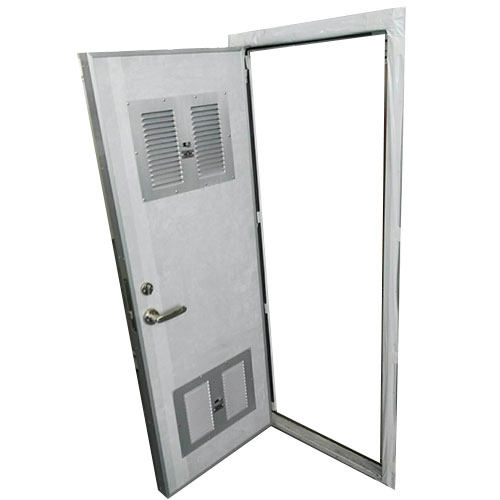
Testing and Certification in Fire and Watertight Rated Marine Doors
| Aspect | Description | Purpose |
| Fire Resistance Testing | Doors are subject exposed to controlled fire for a period of time to determine endurance (e.g. 30, 60, 90, etc.) | Check that the door is able to be able to withstand fire and keep its integrity |
| Heat Transmission Test | The test measures heat transfer via the doors during testing for fire | Make sure the temperature on the side that is not in fire is maintained |
| Smoke Leakage Test | Tests door seals to ensure smoke entry | Verify smoke-tightness for crew safety. |
| Hydrostatic Pressure Test | Simulates water pressure conditions in order to test the watertightness | Verify that the door is resistant to floods without leaking |
| Leakage Testing | Evaluates the effectiveness of sealing under pressure and movement | Confirm that there isn’t any water ingress at all under operating conditions |
| Material and Structural Inspection | Examine the quality of materials, welding, seals and overall quality of construction | Make sure that the material is durable and in compliance with standards |
| Certification by Classification Societies | Approval and review of DNV, ABS, Lloyd’s Register and others. | Official confirmation of compliance for use in the marine environment |
| Installation Inspection | Verification onboard of the door fittings seals, door fittings, and operating mechanisms | Check that the installation is functional and correct |
| Periodic Maintenance Checks | Inspections, tests and checks are conducted regularly are conducted during survey of vessels | Keep door functioning throughout the service duration |
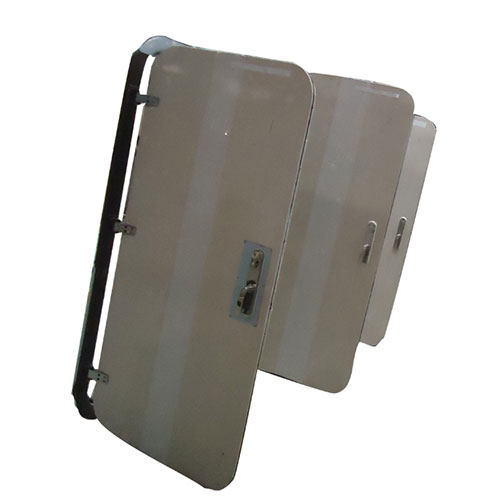
Key Factors to Consider for Choosing Fire and Watertight Rated Marine Doors
Selecting the best fire and watertight rated marine doors is vital to the safety of vessels, regulation compliance as well as effectiveness.
- Regulatory Compliance: One of the primary to consider to consider is whether or not the door conforms to the international and classification society standards like SOLAS, IMO Fire Safety Code and has been approved by organizations such as DNV, ABS, or Lloyd’s Register. The door’s compliance ensures that it will work as it should in an emergency.
- Fire Resistance Rating: Fire-rated doors are classified like A-60 B-30, C-15 or A-60 which indicate how long they are able to withstand fire exposure. The purpose of the doors (engine room or accommodation area, etc.) determines the rating of fire resistance to ensure sufficient protection.
- Watertight Integrity: The door should be able to withstand pressures from hydrostatics that are equivalent to the max operational depth as well as flooding scenario. The sealing mechanism, locking mechanism and door construction have to be able to ensure that there is no leakage in these conditions.
- Material and Construction: In general, doors are constructed of aluminum or steel with the protection of fire-resistant insulation. The material choice affects the weight and durability, corrosion resistance and maintenance ease. The reinforced structure with the highest-quality seals ensure that the structure is maintained over time.
- Operation and Accessibility: Doors can be operated manually or hydraulically operated either sliding or hinged according to space availability and the operational requirements. Fast and reliable opening and closing mechanisms are vital for a safe evacuation as well as emergency response.
- Maintenance and Inspection: Easy maintenance and regular inspections must be taken into consideration. Doors that have seals that can be replaced and parts make maintenance simpler and provide long-term durability.
- Integration with Safety Systems: Integration with the onboard alarm remote control, onboard alarm and locking systems increases security in operation. Integration allows for central monitoring and control in times of emergency.
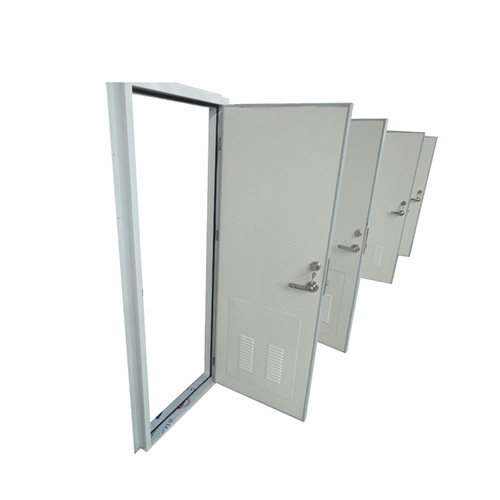
Final Thoughts
Fire and watertight rated marine doors are vital to marine safety, shielding vessels from fire hazards as well as flooding. Conformity to international standards guarantees security in emergencies, protecting vessels and assets at sea. Shipbuilders and operators should prioritise premium and certified marine doors to ensure regulatory compliance and increase onboard safety.


